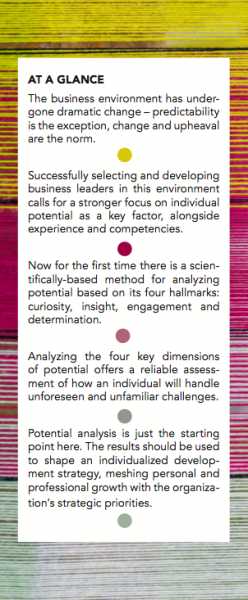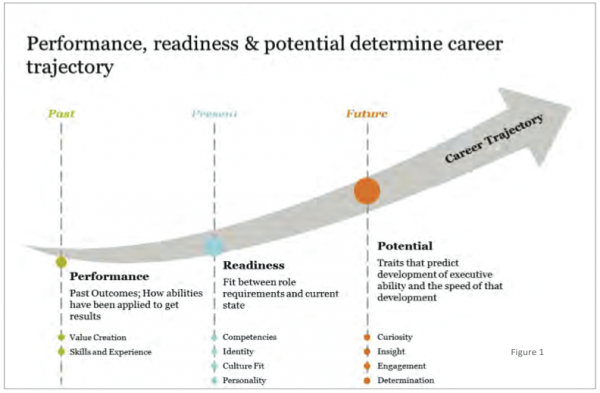Companies are investing more aggressively than ever in executive recruiting, assessment and development. Yet despite this higher level of input, the development tends have little or no impact for executives in a fast-changing market environment; the implication being the methods used to select and develop talent have not kept pace with the changing requirements for effective leadership.
In less volatile days it made sense to assess candidates by looking at their past performance and current competency profile. But now that constant change has become the norm – and today that often means the radical transformation of established business models – assessing existing competencies is simply not enough. The essential thing is to look at an executive’s potential to grow, both professionally and personally.

A case study in disenchantment
One of our clients is a medium-sized company operating in a highly-competitive market environment that is driven by very short innovation cycles. The business is navigating a period of extreme volatility, including a rapid succession of upswings and downturns, and the challenges presented by digital disruption in their space and an expanding and more global competitive landscape have only made matters worse. Suddenly, the company is unable to see clearly where it will be five years down the road, and a market that was once the province of established players is witnessing the emergence of super-agile newcomers who are quickly taking the lead.
The company recognizes it needs a new CEO to address these strategic challenges. Before the search process starts, the competencies that the new leader will need are finely catalogued, with expert help. Candidates are subjected to in-depth analysis and their track records are scrutinized in minute detail. Following numerous interviews and exhaustive assessments, the choice is finally made: a candidate who – according to all the interview and evaluation findings – makes an outstanding match for the company and its current challenges.
Two years later, the disenchantment sets in. The CEO’s contract is not renewed and the search process is starting up again. The volatility of the market has now penetrated deep into the organization’s fabric; fear and uncertainty are spreading. The leader, who was highly qualified in competency terms, appears overwhelmed by the continuous and rapid pace of change, and has so far failed to articulate a strategy that addresses the specific challenges the company is facing.
Stories like this are increasingly common. Companies are struggling to identify the right candidates for rapidly evolving or emerging roles, and to develop a pipeline of effective leaders within their own organizations over the long-term.
Many companies are starting to recognize the stark reality: leaders so carefully selected in the past are not well suited to the challenges of the present. And anyone selecting an executive today solely on the basis of a pre-defined wish-list of competencies and prior experience is assuming that their business environment will remain unchanged. The new global business reality, where sophisticated strategies are rendered obsolete faster than they can be implemented, calls for a new kind of leadership – and a new way of assessing and developing them.
A ‘potential’ solution
We think the answer lies in changing the focus: It is critical to understand an individual’s potential – their ability to handle uncertainty, their comfort-level in dealing with and driving change, and their desire to stretch and grow into increasingly responsible roles. An analysis of potential reveals whether someone can handle the unknown confidently, appropriately and creatively; traits that are decisive in determining whether a company prospers or fails in our volatile times. When considered through the lens of potential, a leader’s past performance and current competency become helpful barometers to determine how much of his/her potential as an executive has been unlocked, but the more relevant and layered insight becomes how suited he or she is for a particular leadership role.
Assessing for potential allows us to adjust the criteria used to select executives and how to identify and cultivate the next generation of leaders. If organizations need leaders capable of handling situations of uncertainty confidently and effectively – and most do – then they must expand the scope of their vision to take leadership potential into account.
The four core traits that indicate potential
Potential means an individual’s capacity for personal and professional growth at work. Analyzing an individual’s potential means looking at their ability to handle familiar or current challenges even more effectively, and, most importantly, his or her ability to adapt to complex challenges that are still unknown.
Egon Zehnder has developed a scientifically-based model for measuring potential. We took as our starting point the findings of high-profile researchers in this field, configuring the resulting model of potential by feeding in the empirical and experiential data yielded by many years of executive assessment practice. We followed this up with an intensive test phase in which we trialed the analysis tool in a large number of organizations.
This potential model assesses individuals with respect to four traits: Curiosity, Insight, Engagement, and Determination.
-
Curiosity Driven to proactively seek understanding and new learning through gaining new ideas, experiences and information. This insatiable curiosity is energized by change, experimentation and feedback.
-
Insight Processes a vast range of information from many kinds of sources and uses it to shape insights that make sense of ambiguity, simplifies complexity and breaks the status quo. This is where conceptualization, creativity and energy meet.
-
Engagement Connects with people because he or she resonates with their motivations, priorities and logic. Their enthusiasm, energy and sense of purpose are infectious: Engages the hearts and minds of others to deliver shared objectives and mutual benefits. Gains energy from authentically connecting with others and understanding them at a deeper level.
-
Determination Enjoys a challenge, overcomes obstacles and willingly takes on higher risk opportunities with ingenuity and tenacity. Possesses the self-discipline to focus and stay with the challenge. However, does not let strength of purpose descend into mere stubbornness. Continues to look for disconfirming evidence to stay nimble and change direction when needed.

High performers are not necessarily high potentials
The four core aspects of potential of course also impact on many of the established leadership competencies, including change leadership, strategic thinking and results orientation. Yet, the key to understanding the traits that indicate potential is their predictive character; in other words, they do not describe current levels of attainment, but provide insight into how an individual’s specific competencies could develop in the future. When organizations are deciding who should be developed or selected for higher-level roles, it is not enough to focus exclusively on the present. We regularly encounter individuals who excel in their current roles, but whose potential indicators are nothing out of the ordinary.
In fact, only a minority of current high performers is actually high potential – and equating the two is misleading. Our research and observations show us time and again that only a minority of current high performers have genuine future potential. Conversely, high potentials who are not ideally placed in their current role and therefore do not rank among the top performers can vanish from the frame altogether. The consequences of this can be serious: The organization may invest in individuals who have little potential beyond their current role, while those with genuinely high potential are overlooked completely, relegated to ill-fitting roles where they cannot excel, or worse – lost to the competition.
Developing the executives of the future
For the first time, potential analysis offers a method that can accurately measure the developmental potential of executives and emerging talent. But what happens next, when the results are available? How do we effectively develop executives on an ongoing basis, based on the results of the assessment? The quality of any executive development program is defined by whether it facilitates timely and targeted personal and professional growth.
What is needed is a genuinely holistic approach that breaks with current development practice, which frequently falls into two distinct categories – standardized development offerings on the one hand (bad) and individualized, personality-oriented offerings on the other (good). But with many business schools supplementing their executive education offerings with a token few hours of personal coaching, what often emerges is an anemic mix of off-the-shelf solutions with a touch of superficial customization. This is symptomatic of the problem rather than representing any kind of solution.
We perceive that development has a real chance of working when interventions are:
-
focused on a goal the individual executive genuinely wishes to achieve;
-
facilitate the unlocking of individual potential;
-
personalized; and
-
woven into the executive’s everyday leadership role and culture in which he/she works.
In other words, competency and potential analyses are the starting points for personalized development pathways. Their outcomes offer key indications of developmental potential, but cannot replace defining those specific development goals by individual executives themselves.
Leveraging the potential of organizations
Potential analysis has made it possible to measure leadership capability in a way that was previously overlooked or addressed only at “gut instinct” level. And while richer and far more insightful than competency and experienced based assessments, potential analysis alone is still not enough. It is only by embedding individual development strategies within everyday structures that organizations can successfully create a fertile environment for growth.
Addressing today’s far more complex leadership challenges calls for a new perspective. Organizations that establish potential as a key component of executive evaluation will be able to tap into previously unlocked capability that can handle the rapidly changing, disruptive and often volatile nature of today’s business environment, and meet the unknown challenges of the future challenges – utilizing their most valuable “raw material” to optimum effect.
Summary
Finding the right leaders for tomorrow’s challenges is critical to success for organizations today. An innovative model and approach to assessing leadership potential makes it possible to analyze four key dimensions – curiosity, insight, engagement and determination. Uncovering the degree to which a leader possesses these traits acts as the starting point for holistic, individualized leadership development measures that focus on personal and professional learning and growth opportunities that are closely aligned with the organization’s strategic priorities. In combination, these efforts will fuel any organization’s future success.
Topics Related to this Article
This article was first published in Talent Quarterly #6 and is republished on this website with kind permission of the magazine.





